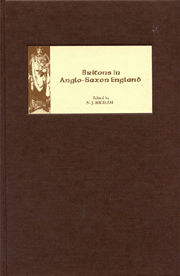Book contents
- Frontmatter
- Contents
- List of Illustrations
- List of Tables
- Contributors
- Dedication
- Acknowledgements
- Abbreviations
- 1 Britons in Anglo-Saxon England: An Introduction
- 2 Anglo-Saxon Attitudes
- 3 Forgetting the Britons in Victorian Anglo-Saxon Archaeology
- 4 Romano-British Metalworking and the Anglo-Saxons
- 5 Invisible Britons, Gallo-Romans and Russians: Perspectives on Culture Change
- 6 Historical Narrative as Cultural Politics: Rome, ‘British-ness’ and ‘English-ness’
- 7 British Wives and Slaves? Possible Romano-British Techniques in ‘Women's Work’
- 8 Early Mercia and the Britons
- 9 Britons in Early Wessex: The Evidence of the Law Code of Ine
- 10 Apartheid and Economics in Anglo-Saxon England
- 11 Welsh Territories and Welsh Identities in Late Anglo-Saxon England
- 12 Some Welshmen in Domesday Book and Beyond: Aspects of Anglo-Welsh Relations in the Eleventh Century
- 13 What Britons Spoke around 400 AD
- 14 Invisible Britons: The View from Linguistics
- 15 Why Don't the English Speak Welsh?
- 16 Place-Names and the Saxon Conquest of Devon and Cornwall
- 17 Mapping Early Medieval Language Change in South-West England
- Index
16 - Place-Names and the Saxon Conquest of Devon and Cornwall
Published online by Cambridge University Press: 12 September 2012
- Frontmatter
- Contents
- List of Illustrations
- List of Tables
- Contributors
- Dedication
- Acknowledgements
- Abbreviations
- 1 Britons in Anglo-Saxon England: An Introduction
- 2 Anglo-Saxon Attitudes
- 3 Forgetting the Britons in Victorian Anglo-Saxon Archaeology
- 4 Romano-British Metalworking and the Anglo-Saxons
- 5 Invisible Britons, Gallo-Romans and Russians: Perspectives on Culture Change
- 6 Historical Narrative as Cultural Politics: Rome, ‘British-ness’ and ‘English-ness’
- 7 British Wives and Slaves? Possible Romano-British Techniques in ‘Women's Work’
- 8 Early Mercia and the Britons
- 9 Britons in Early Wessex: The Evidence of the Law Code of Ine
- 10 Apartheid and Economics in Anglo-Saxon England
- 11 Welsh Territories and Welsh Identities in Late Anglo-Saxon England
- 12 Some Welshmen in Domesday Book and Beyond: Aspects of Anglo-Welsh Relations in the Eleventh Century
- 13 What Britons Spoke around 400 AD
- 14 Invisible Britons: The View from Linguistics
- 15 Why Don't the English Speak Welsh?
- 16 Place-Names and the Saxon Conquest of Devon and Cornwall
- 17 Mapping Early Medieval Language Change in South-West England
- Index
Summary
THE comparative absence of Brittonic place-names in most of England has long been a notable problem for anyone wishing to postulate large-scale survival of the native British population into the Anglo-Saxon period. In recent years these names have received useful attention, but the overall picture nevertheless remains little changed from what it was fifty years ago. Linguistically, too, the lack of British loan-words or other influences in English continues to be a powerful argument, despite unconvincing attempts to suggest syntactic and other borrowings. In recent years Margaret Gelling has given the question brief but valuable discussion; here I shall demonstrate one aspect of the lack of Brittonic place-names, and discuss its implications and some possible models for interpreting it.
Cornwall is almost the only part of England where extensive Brittonic survival is not in question, since the language continued to flourish, in the western half of the county, down to the early modern period, and has left remains in the form of medieval literary works. As one crosses the county boundary from Devon, the place-names change noticeably. The situation can be illustrated by means of maps showing complementary images: first, the distribution of a habitative place-name element, Cornish tre ‘farmstead, estate’ (Illus. 16.1), which is so widespread that it almost serves to define Cornishness in place-names. With about 1,200 examples in total, tre occurs almost throughout Cornwall, except on the upland moors for obvious reasons.
- Type
- Chapter
- Information
- Britons in Anglo-Saxon England , pp. 215 - 230Publisher: Boydell & BrewerPrint publication year: 2007

